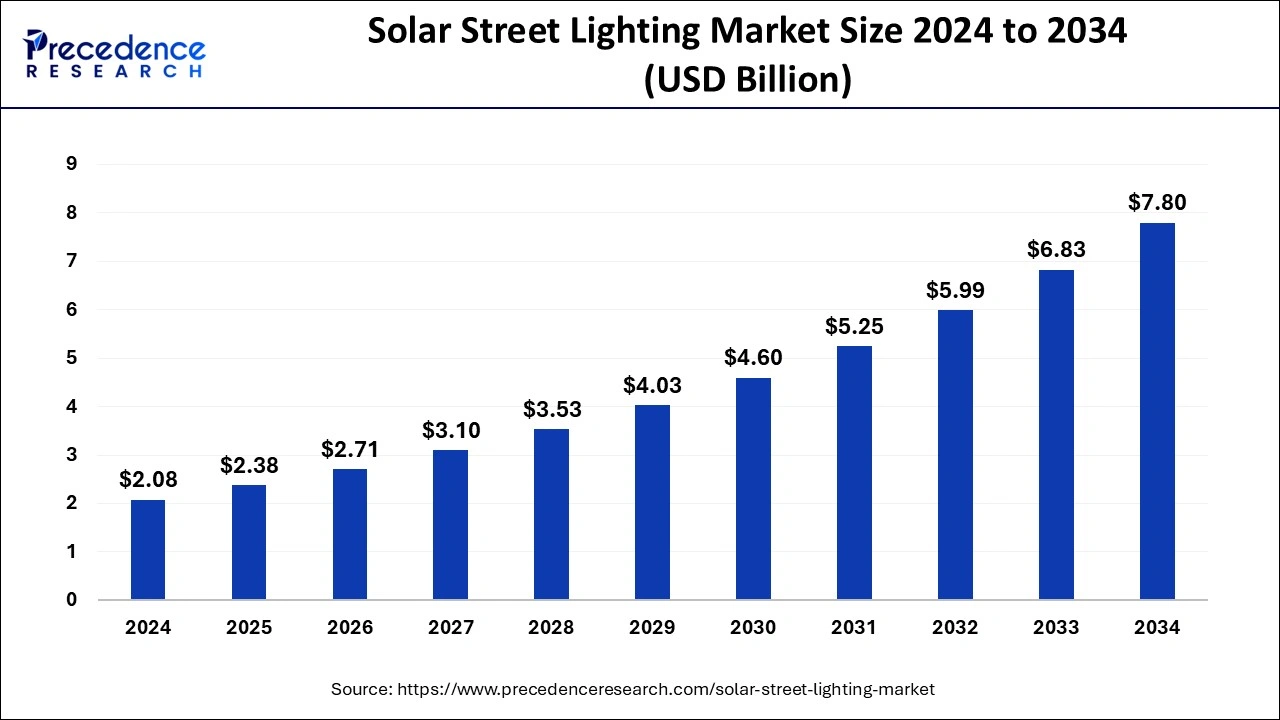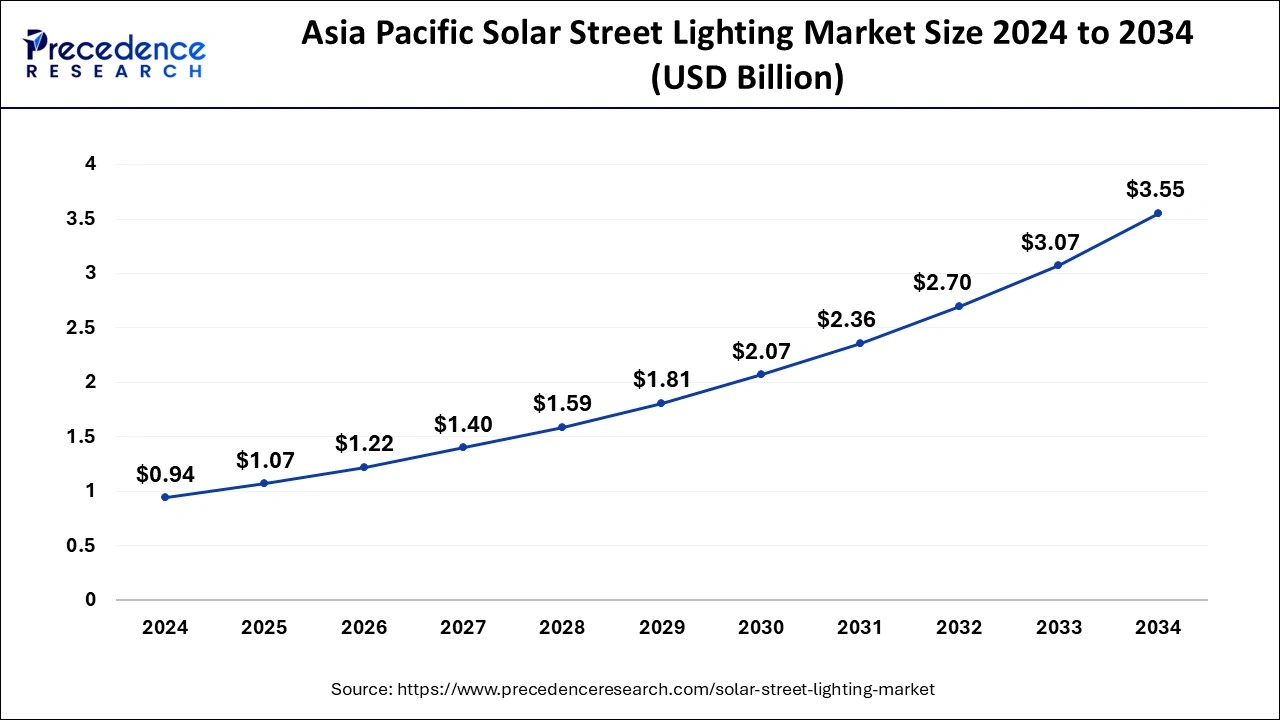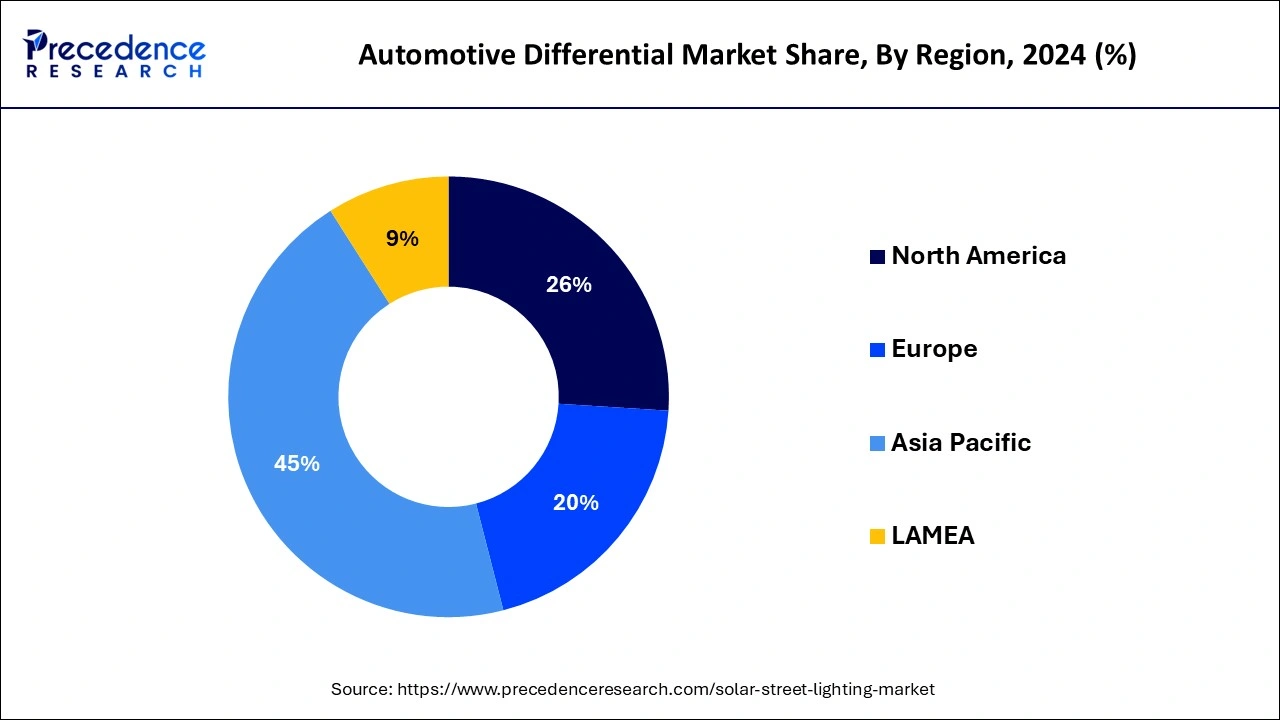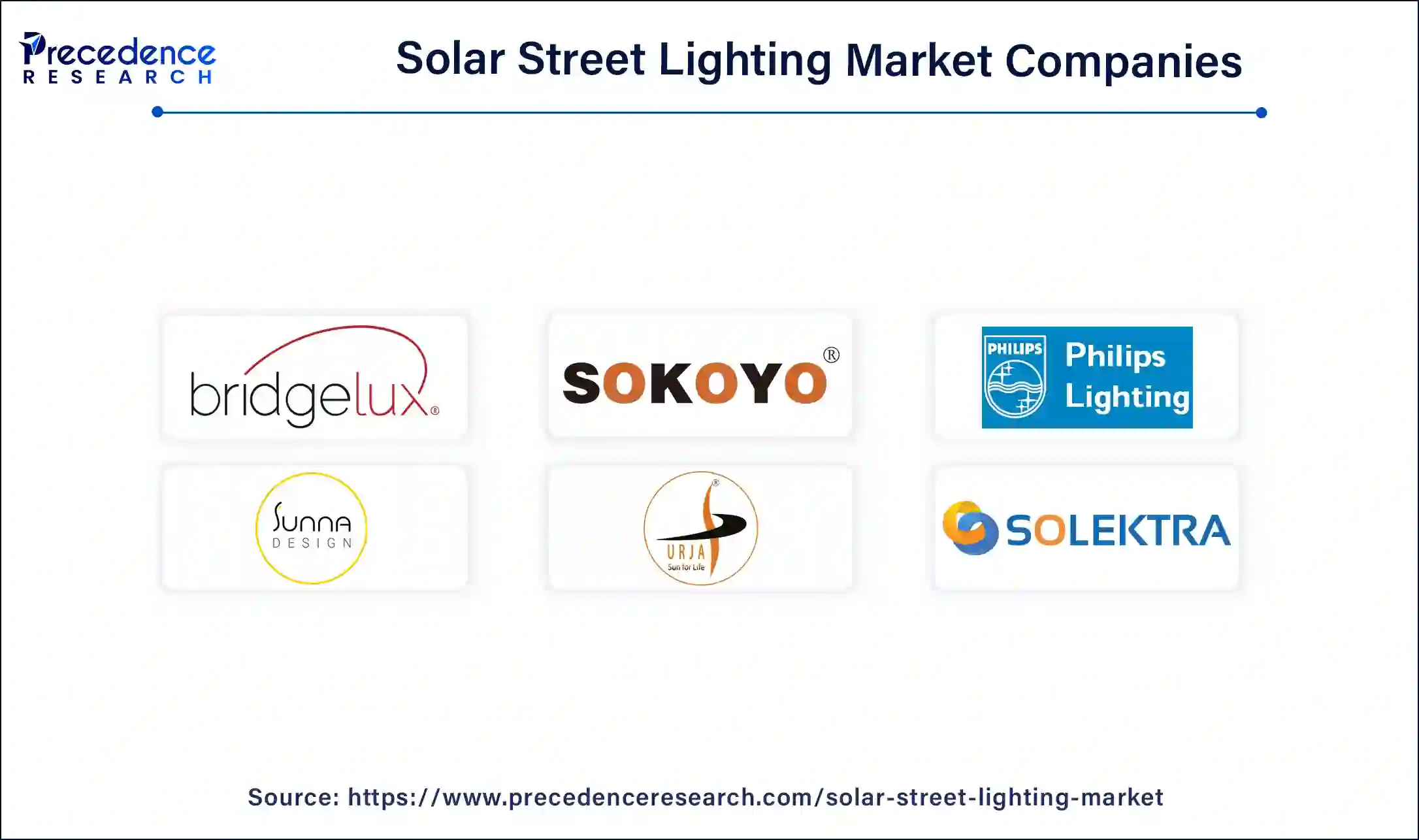October 2024
The global solar street lighting market size is calculated at USD 2.38 billion in 2025 and is forecasted to reach around USD 7.80 billion by 2034, accelerating at a notable CAGR of 14.11% from 2025 to 2034. The Asia Pacific market size surpassed USD 0.94 billion in 2024 and is expanding at a CAGR of 14.21% during the forecast period. The market sizing and forecasts are revenue-based (USD Million/Billion), with 2024 as the base year.
The global solar street lighting market size was worth around USD 2.08 billion in 2024 and is anticipated to reach around USD 7.80 billion by 2034, growing at a CAGR of 14.11% from 2025 to 2034. The demand for energy-efficient solutions has increased, driving the growth of the solar street lighting market. The rising awareness of renewable energy and government initiatives and promotions are significantly fueling the market expansion.

Artificial Intelligence has become a crucial player in helping businesses to reduce their carbon emissions. AI is helping with the development of the solar street lighting market, by integrating it with renewable energy and other maintenance systems. Solar street lighting rapidly faces challenges of energy efficiency and lack of personalized experiences. However, with the integration of cutting-edge technology like AI, IoT, and building management systems, the industry is projected to witness novel and innovative developments to overcome market challenges and implementation difficulties.
The integration of AI is not only helping to design solutions in the solar street lighting market with more safety and security but also making them human-centric, more sustainable, and cost-effective. With the help of AI, the manufacturing industries are emerging to transform the overall game. Additionally, concerns regarding traffic monitoring and crime detection are expected to be resolved through AI integration with solar street lighting in the future. With the integration of AI, the market is likely to find ways to achieve further success in the coming years.
The Asia Pacific market size was evaluated at USD 0.94 billion in 2024 and is projected to be worth around USD 3.55 billion by 2034, growing at a CAGR of 14.21% from 2025 to 2034.

Asia Pacific dominated the global solar street lighting market in 2024 due to rapidly growing urbanization and increased adoption of sustainable solutions in developing countries of Asia. Asia has further witnessed significant growth in the market due to ongoing government initiatives and policies for renewable energy and subsidies offering for the adoption of solar street lighting. Advanced solar panel efficiency is helping to reduce costs and improve the performance of solar streetlights, making them more popular among regional people. The commercial areas, like parking lots, gardens, sports grounds, and subways, are majorly installed with solar street lighting solutions.
China is leading the regional solar street lighting market due to its presence of large-scale manufacturing industries of solar street lighting, making them more affordable in the country, which leads to its vast adoption rate. The increased urbanization of China is supporting the broad adoption of this lighting. However, increased government policies and funding are driving significant market growth in India. Additionally, the collaboration between key companies and the government is highlighting the market growth in India.

North America is projected to host the fastest-growing solar street lighting market in the coming years. The growth of the market in North America is significantly growing due to rising government policies and initiatives like renewable energy targets and tax credits and incentives to encourage the adoption of solar street lighting in the region.
The United States is leading the regional solar street lighting market with the presence of key players. Additionally, the growth of the market in the United States has taken speed due to government and regulatory pressure for utilizing sustainable solutions as well as investments in research & developments, which empower the sector for the development of advanced technologies such as energy storage capacity and smart lighting technologies.
On the other hand, Canada accounted for the second-largest country, fueling the solar street lighting market expansion in the region due to the availability of major market players like Carmanah Technologies and SolarOne Solutions. Government investment & support, technology advancements, and the presence of top competitors are the major factors driving market expansion in North America.
The solar street lighting market provides data regarding industries that provide solar lighting for streets, roads, and other areas. Increasing urbanization has led to the adoption of affordable yet energy-efficient lighting solutions. Besides, the government and environmental regulatory determination to reduce carbon emissions encourages industries. Several non-governmental organizations and key companies are rapidly investing in the development of solar-based lighting solutions to prevent carbon footprints and focus on renewable energy efficiency.
The major trend for smart houses and smart cities is the key factor that is driving the growth of the global solar street lighting market. Moreover, the adoption of cutting-edge technologies is allowing the availability of smart and advanced solar street lighting, making them further popular and preferred by consumers. The integration of advanced technologies such as IoT sensors and real-time monitoring software is enabling the spectacular transformation of solar street lighting solutions and their adoption rate with rising sustainability concerns, electric bill issues, technology advancements, and smart city developments.
| Report Coverage | Details |
| Market Size by 2024 | USD 2.08 Billion |
| Market Size in 2025 | USD 2.38 Billion |
| Market Size in 2034 | USD 7.80 Billion |
| Market Growth Rate from 2025 to 2034 | CAGR of 14.11% |
| Dominating Region | Asia Pacific |
| Fastest Growing Region | North America |
| Base Year | 2024 |
| Forecast Period | 2025 to 2034 |
| Segments Covered | Type, Application, Lighting Sources, and Regions. |
| Regions Covered | North America, Europe, Asia-Pacific, Latin America, and Middle East & Africa |
Surge of Sustainability
The growing awareness education of carbon emissions and the surge in the adoption of solar street lighting has witnessed the rapid growth of the solar street lighting market not only in urban but also in developing areas. The rapidly growing urbanization has drawn concern over reducing reliance on fossil fuels and populations, where the government has initiated and encouraged the utilization of solar street lighting solutions. Moreover, less energy consumption and low maintenance requirements for this lighting are becoming valuable cost-saving solutions.
With an increased focus on renewable energy, the surge toward the solar street lighting market has been enhanced. With the help of advanced technologies, solar street lighting has become more efficient and more affordable, making them majorly popular. With the development of smart cities, the demand for smart solar street lighting with smart lighting technologies, including IoT sensors and energy management systems to improve efficiency and effectiveness, has emerged in the market. With growing sustainability awareness, government support, and technology developments, the adoption of solar street lighting is continuously increasing.
Technology limitations
The solar street lighting market faces several challenges, as solar street lights are not very bright, and storage issues are a common challenge for this lighting. Even with LED batteries, the lighting's brightness can’t match the traditional lighting solutions. Several technology limitations, like battery lifespan, energy storage limitations, panel efficiency, light distribution, limited integration of automation, lack of standardization, and lack of real-time monitoring capabilities, are significantly hampering the adoption of solar street lighting. However, there is a rise in government and company investments in research and development.
Government Initiatives
The rising government focus on environmental sustainability is the key reason behind increased support and encouragement for the adoption of off-grid solar street lighting market solutions. The government policies like Renewable Portfolio Standards, Net Metering, Building Codes, and Standards for Generating Utility encourage the utilization of solar street lighting. Moreover, government initiatives should increase awareness and promote various programs, including training and capacity-building programs for professionals to train them to design, install, and maintain solar street lighting systems.
The standalone solar street lighting segment contributed the highest solar street lighting market share in 2024 due to various factors, including its independence, energy efficiency, and low maintenance. The adoption of standalone solar street lighting in rural areas has increased due to limited energy access and grid infrastructures. The easy installation of standalone lighting is making them more popular. Additionally, as standalone solar street lighting consumes very little energy and needs low maintenance, they are more affordable compared to on-grid lighting. Moreover, with the surge toward the adoption of off-grid lighting and government initiatives in environmentally friendly solutions, the adoption of standalone lighting has increased. With ongoing technological advancements in panel efficiency, battery technology, and LED lighting, standalone lighting efficiency has improved, leading to further adoption.
The light-emitting diodes (LEDs) segment captured the biggest share of the solar street lighting market in 2024 due to its energy-efficient and battery-efficient properties. Additionally, the longer lifespan of LEDs contributes to less maintenance requirements and cost-effectiveness. Consumers have been attracted to LED street lighting in recent years due to their flexibility in maintaining color temperature and intensities. The increased need for less energy-consumptive, durable, and flexible lighting solutions.
The commercial segment held the largest share of the solar street lighting market in 2024. The segment growth is attributed to the continuous adoption of energy-efficient and affordable lighting solutions in commercial sectors such as sidewalks, subways, parking lots, building perimeters, warehouses, and loading docks. The government has supported commercial establishments for the adoption of solar street lighting, making the segment more successful. Additionally, growing sustainability concerns have increased demand for solar street lighting to reduce environmental impacts, which has led to vast implementations in commercial areas.

By Type
By Application
By Lighting Sources
By Geography
For inquiries regarding discounts, bulk purchases, or customization requests, please contact us at sales@precedenceresearch.com
No cookie-cutter, only authentic analysis – take the 1st step to become a Precedence Research client
October 2024
August 2024
January 2025
August 2024